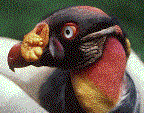







As everyone knows, birds lay eggs -- specifically, they lay very typical amniote eggs with calcified shells. Birds brood their eggs until hatching. Some bird species are naked and helpless at birth, and must be fed by their parents; these birds are said to be altricial. Many common songbirds, such as the American robin, are altricial species. Precocial birds, on the other hand, are born feathered, and are able to walk and to feed on their own shortly after hatching -- ducks and chickens are well-known precocial birds. Whether precocial or altricial, birds grow rapidly, reaching adult size within one year.
A phenomenon that has been well studied in birds is altruism. In altricial species, the parents of hungry nestlings may be helped in feeding and guarding their young by other adult birds who have not bred that year. This may seem contrary to "survival of the fittest" concepts of evolution, in which lineages that do not maximize reproductive output are supposed to go extinct. However, the "altruistic" helper birds are closely related to the parent birds and their offspring -- which means that they share many genes with the young birds they are helping to raise. By helping the parents ensure the survival of their offspring, helpers are ensuring that their own genes will be passed on to the next generation.
 Birds as a whole feed on a wide range of foods, from fish and flesh to insects
to fruits and seeds, and in the case of the New Zealand kea, occasionally sheep's blood.
Living birds lack teeth, and the jaws are covered by a horny beak, which often
shows adaptation to the bird's particular diet: long, slender
beaks for probing for insects, flat or paddle-shaped beaks for sieving food out
of the water, heavy beaks for cracking and crushing seeds, or sharp, hooked
beaks -- like that of the vulture depicted at right -- for tearing flesh.
Birds as a whole feed on a wide range of foods, from fish and flesh to insects
to fruits and seeds, and in the case of the New Zealand kea, occasionally sheep's blood.
Living birds lack teeth, and the jaws are covered by a horny beak, which often
shows adaptation to the bird's particular diet: long, slender
beaks for probing for insects, flat or paddle-shaped beaks for sieving food out
of the water, heavy beaks for cracking and crushing seeds, or sharp, hooked
beaks -- like that of the vulture depicted at right -- for tearing flesh.
Birds play important roles in the control of insects and, perhaps more importantly, in the pollination and dispersal of flowering plants. A number of flowering plants have flowers which are structurally modified for bird pollination. These flowers typically are colored bright red, which is visible to birds, and produce large quantities of sugar-rich nectar on which the visiting birds feed. In the Old World, there is often a perch provided, but in the New World, where there are hummingbirds capable of hovering, such perches are generally not found. In addition to pollination, birds are important dispersers of many plant seeds. These plants ripen fruits which again are a bright red, and have thick coats on their seeds to protect them should they be swallowed.


